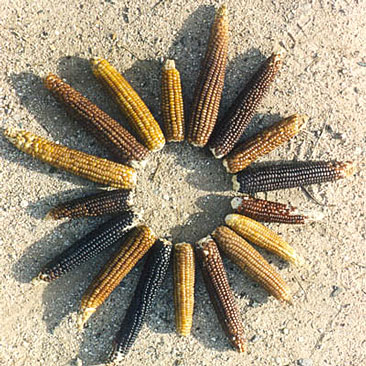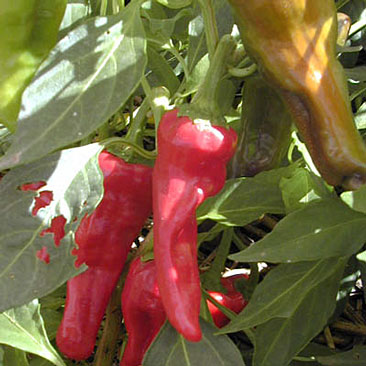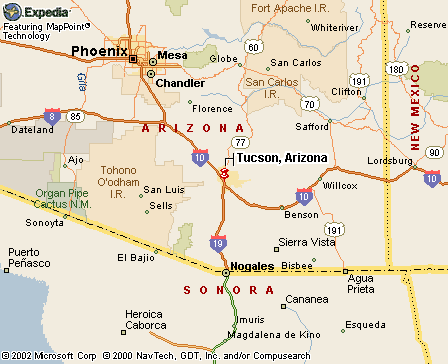|
|
Canku Ota |
|
|
(Many Paths) |
||
|
An Online Newsletter Celebrating Native America |
||
|
July 27, 2002 - Issue 66 |
||
|
|
||
|
A Seed-saving Project Sprouts in the Southwest |
||
|
by Carole McCray | Special
to The Christian Science Monitor
|
||
|
|
|
But one bank in Tucson doesn't fit any of those descriptions. This bank is filled with thousands of seeds. Not just any seeds of course; Big Boy tomato seeds are so common they wouldn't need to be kept in a vault. Instead, these are endangered native American seeds – some of which date to prehistoric times. They include beans with purple stripes and speckles, a black chili pepper, and corn with red, white, and blue kernels. The repository of all these unusual seeds is known as Native Seeds/SEARCH (Southwestern Endangered Arid-Land Resource Clearing House). It is a nonprofit conservation, education, and research group formed to save regional crops. Because its mission is solely to preserve and pass on Southwestern seeds, Native Seeds/SEARCH (NS/S) has become a leader and specialty clearinghouse devoted to gathering, storing, and distributing rare native American seeds. It all began when ethno-botanist Gary Nabhan and activist Mahina Drees worked for Meals for Millions, a hunger-fighting program of the United Methodist Church. Volunteers collected food by harvesting the remains of crops abandoned in fields following the main harvest. Then they distributed the gleanings among a southern Arizona native group known as the Tohono O'odham. Thinking that they would help the tribe even more by encouraging them to grow their own vegetables, Meals for Millions workers decided to give vegetable seeds to the Tohono O'odham. The reaction wasn't what they expected. According to Barney Burns, a cofounder of NS/S, the recipients responded, "It's real nice of you folks to offer us radishes and broccoli, but what we're looking for are the plants that our grandparents used to grow." So Mr. Nabhan and Ms. Drees began a search for heirloom seeds by making inquiries among Tohono O'odham elders to find those who had seeds from their gardens or from old gardens. This is harsh growing country, with elevations of 3,500 feet and higher, and summer temperatures regularly exceeding 100 degrees F. Despite the region's marginal growing conditions, native American farmers in the region have raised many varieties of food through the centuries. As late as 1925, the Tohono O'odham people cultivated 10,000 acres with traditional floodwater methods, dependent on summer rains. But cultural changes, land transfers, and environmental destruction resulted in fewer and fewer farms and gardens being planted. Today, only a few scattered plots remain. As the importance of agriculture diminished in the tribe's life, traditions were lost. Also, according to some researchers, turning away from native crops had an adverse effect on the health and nutrition of the people. This was the trend that Nabhan and Drees hoped to reverse when they began their search for surviving native seeds that had been passed down from generation to generation.
In the early days of the project, the founders stored the seeds in their home freezers. Then they kept some at the Tucson Botanical Garden. But in 1983, Native Seeds/SEARCH was founded to consolidate the seed-saving and -distributing activities. By 1995, NS/S had three locations, including Sylvester House, an old adobe house in central Tucson. One of the two buildings on the 3/4-acre property was turned into a seed bank. It holds five large freezers filled with seed samples and a separate cold room containing several hundred jars and buckets of seeds. The group now has 2,000 accessions (an accession is one seed collection from a particular place and time). They represent 99 species of crops from 17 tribal groups – Apache, Chemehuevi, Cocopah, Gila River Pima, Guarijio, Havasupai, Hopi, Maricopa, Mayo, Mojave, Mountain Pima, Navajo, Paiute, Pueblo, Tarahumara, Tohono O'odham, and Yoeme. Half of the collection consists of varieties of corn, beans, and squash. These important crops were known to the Indians as the "three sisters" because when they are planted together, each crop benefits from and enhances the others. Corn stalks, for example, become trellises for climbing beans planted around them. Beans are legumes and fix atmospheric nitrogen (a necessary nutrient) into forms usable by the corn. The large leaves of the squash and its spreading vines shade the ground and help keep it cool and moist. In the corn collection are 500 accessions, strikingly beautiful in diverse sizes, shapes, and colors. Stunning colors catch your attention – Navajo Robin's Egg, a soft grinding corn dotted with blue speckles on white kernels intermixed with solid white and blue kernels. Also, Cocopah, a sweet-eating corn with red, white, and blue kernels, which was originally collected in 1868 from the Colorado River Indians and saved by prospectors in northern Arizona. Like many of the crops grown by native Americans, corn wasn't – and isn't – just for eating fresh. Tribe members may grind corn into flour or for atole, a hot porridge; make it into posole (hominy); or use it as animal feed. Corn is also important in ceremonial events, and various colored kernels are selected for ceremonies and feast foods. Hopi blue Sakwapu, for instance, is ground to make ceremonial piki bread. Hopi farmers plant plum-colored kernels of Hopi Greasy Hair "Wiekte," which matures early, so the harvest is ready for the Home Dance ceremony in July.
The group has also saved 220 varieties of squash. These are a versatile food crop because the flowers, seeds, and growing tips of vines are all edible. Seeds of green-and-white-striped cushaw squash are toasted for snacks or ground to prepare Pipian sauces. Some tribes craft musical instruments from the cushaw's thick, hard shell. The flavorful salmon-colored flesh of Mayo Kama butternut and Magdalena Big Cheese are often turned into great soups and pies. Other rare varieties are preserved in the seed bank. These include amaranths, small-grained seeds grown by the Aztecs and by Southwest Indians. In central Mexico, a confection known as alegria is made by mixing popped blond amaranth seeds and honey. Hopis use the amaranth's red flower bract as a natural scarlet dye to color piki bread. Sonoran panic grass, once believed to be extinct, is now available at the seed bank. This grass is used as forage for horses and cattle, and the tiny seed is harvested for grain. One of the big favorites with the NS/S staff is the Melon de Castillo from the Sierra Madre in Mexico, which is very sweet. Because of the growing need to ensure future survival of the "deposits" in the seed bank and to allow NS/S to make larger quantities of seed available for distribution, the group acquired 60 acres of rich farmland in 1997. Located 60 miles south of Tucson in Patagonia, Ariz., the Conservation Farm allows the staff to demonstrate the potential of ecologically safe and sustainable agriculture. A smaller, garden that emphasizes typical Native American crops from the southwestern US and Mexico is located at the Tucson Botanical Garden, which is near the seed bank. Plants grown by the Tohono O'odham are featured. The summer garden showcases varieties of corn, beans, squash, melons, and chiles. The winter garden yields wheat, onions, and greens. One of the more unusual plants in the garden is known as devil's claw, a dramatically shaped plant. The black fiber from the plant's fruit or "claw" can be woven into a basket for a striking effect. It is a favorite with the O'odhams, who are known for their exquisite baskets. The young fruits of the plant can also be cooked as an okra-like vegetable. Each September, the botanical garden sponsors an all-day educational event to honor and celebrate the traditions of the O'odham people. The celebration features dancing, storytelling, singing, basket weaving, traditional plant foods, and Indian fry bread. An expert at harvesting saguaro cactus from the desert may explain how long saguaro rib poles are used to gather the fruits of the cactus, which are then cooked down to make a syrup. Such support of Indian values and culture is also a key element in the work of Native Seeds/SEARCH. Angelo Joaquin Jr., former executive director of NS/S, who is of Tohono O'odham heritage, tells of a tribal elder's experience on a tour of the seed bank. The elder inquired about the Gila River mottled bean, which she had not seen since her youth, and was overwhelmed when a staff member presented her with a jar of the beans. She was overjoyed to take home beans just like the ones grown years ago by her parents and grandparents. "The seeds represented a tangible connection to her youth, grandfather, and her ancestors," Mr. Joaquin says. He is now affiliated with San Xavier Coop Farm, south of Tucson, where traditional O'odham crops are the focus. When I visited him at the farm, he said: "The seeds are tangible links to our ancestors. We honor [our ancestors] by putting the seeds into the ground." • For further information about Native Seeds/SEARCH, see the website, www.nativeseeds.org, or e-mail info@nativeseeds.org. To obtain a copy of the group's seed catalogue, send $1 to Native Seeds/SEARCH, 526 N. Fourth Avenue, Tucson, AZ 85705. Tours of the seed bank are available. Call (520) 622-5561.
|
|
|
||
|
|
||
| Canku Ota is a free Newsletter celebrating Native America, its traditions and accomplishments . We do not provide subscriber or visitor names to anyone. Some articles presented in Canku Ota may contain copyright material. We have received appropriate permissions for republishing any articles. Material appearing here is distributed without profit or monetary gain to those who have expressed an interest. This is in accordance with Title 17 U.S.C. section 107. | ||
|
Canku Ota is a copyright © 2000, 2001, 2002 of Vicki Lockard and Paul Barry. |
||
 |
 |
|
|
The "Canku Ota - A Newsletter Celebrating Native America" web site and its design is the |
||
|
Copyright © 1999, 2000, 2001, 2002 of Paul C. Barry. |
||
|
All Rights Reserved. |
||
 TUCSON,
AZ - To most folks, a bank is a building where people deposit their
money, an organization that supplies food to the needy, or a place to
donate blood.
TUCSON,
AZ - To most folks, a bank is a building where people deposit their
money, an organization that supplies food to the needy, or a place to
donate blood. At
first, the seeds they were given by tribal elders were passed around
to other interested gardeners, and a sample of each was saved. Soon,
their collection of seeds grew, so that they were able to pass along
seeds of squash, peppers, melons, corn, beans, and other traditional
crops to other native Americans in the Southwest.
At
first, the seeds they were given by tribal elders were passed around
to other interested gardeners, and a sample of each was saved. Soon,
their collection of seeds grew, so that they were able to pass along
seeds of squash, peppers, melons, corn, beans, and other traditional
crops to other native Americans in the Southwest. Sylvester
House holds 275 accessions of beans. A traditional complement to corn,
beans are a diverse and main crop in native American farming. Fava,
garbanzo, lima, tepary, and wild beans are among the legumes banked
at the seed storehouse and made available to native American communities
in the Southwest and to gardeners worldwide through the Native Seeds/SEARCH
catalogue, which is now mailed to 12,000 customers.
Sylvester
House holds 275 accessions of beans. A traditional complement to corn,
beans are a diverse and main crop in native American farming. Fava,
garbanzo, lima, tepary, and wild beans are among the legumes banked
at the seed storehouse and made available to native American communities
in the Southwest and to gardeners worldwide through the Native Seeds/SEARCH
catalogue, which is now mailed to 12,000 customers.